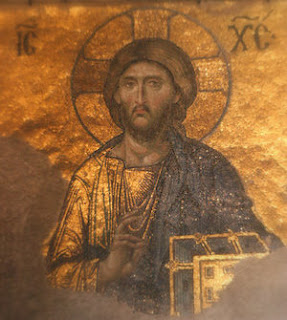At this time of year, one sees more depictions of angels than the rest of the year. I have often wondered how and when they began to be shown as winged women or even babies with wings, since that is never mentioned in the scriptures. I found the following article to be helpful.
History of Winged Angels in Christian Art
Jun 23, 2010 Valerie Williams
History of Winged Angels in Christian Art - Leo Reynolds
Since the 4th century A.D., angels have been depicted as two-winged creatures, as babies, and as women, influenced by pagan images of winged gods.
Angel art is dominated by portrayals of angels as either cute, two-winged baby angels, called cherubs, two-winged female angels, and two-winged male angels. Gracing greeting cards and adorning the edifices of churches, these images are the ones people are most familiar with in typifying an angelic being.
 |
| Abraham and the Angels, Rembrandt |
Description of Winged Angels in the Bible
The two types of winged angels described in the scriptures are cherubims and seraphims. According to the prophet Ezekiel, cherubims have four wings. The word "cherubims" derives from the Hebrew word
keruwb, and refers to an angelic being with four wings (Strong's Concordance H3742). In the book of Isaiah, seraphims are described as having six wings. This word derives from the Hebrew word
saraph, which also refers to an angelic being, and comes from the root word which means to burn (Strong's H8313-14). This description of what an angelic being is composed of accords with Psalms 104:4 which describes angels as flaming fire.
Depictions of Angels in Pre-Christian Art
Ancient Egyptians, and later the ancient Greeks, depicted their gods as winged creatures. Greek gods such as Hermes and Perseus were illustrated as deities with two wings. Cupid was a Roman god who was portrayed with two wings. Early Christian art did not portray angels with wings; instead, early depictions of angels in Christian art were often presented as men in human form, often dressed in robes.
As well as pagan gods, pagan goddesses were also featured as winged creatures; thus, the images of female angels abounded in pre-Christian art. Winged Victories, called Nikes, were women with wings, often holding a victor's wreath on which they inscribed a victory over an enemy. In Roman art, female angels often appeared partially clad in long, flowing robes. These images portrayed these female angels with two wings.
Constantine's Reign and its Effect on Angel Art
Portrayals of angels in Christian art began to change with the advent of Constantine's reign as emperor of Rome in the 4th century. The council of Nicea in 325. A.D. formed Christianity as the religion of the state, and it was after this that angels with wings, baby angels, and female angels, as well as halos, began to appear in Christian art. Prior to this period Christian art did not portray angels with wings so as not to give the impression of paying homage to a host of pagan deities as did the ancient Greeks, Romans, and Egyptians.
However, after the 4th century, angels with wings not only began to appear in Christian art, but also began to mimic the winged deities found in ancient Mesopotamian art. The image of a cherub as a tiny, winged baby follows the tradition of the art found in ancient Rome and Greece, and has no resemblance to the description of the cherubims described by Ezekiel in the bible.
Halos also began to appear in Christian art after the 4th century. Prior to this, halos were painted above the heads of pagan gods or emperors. The word "halo" comes from the Greek and Roman god Helios. Helios was often adorned with a sunburst or ring of light around his head, called a "gloria". The term "gloria" derives from the Roman goddess Gloria, who held the zodiac sign. Halos began appearing with regularity, adorning the heads of angels as well as the Madonna and other Catholic saints.
By the fifth century, winged angels in Christian art became commonplace. Scenes such as the Anunciation depicted on St. Mary Major's and two mosaics of St. Apollinare Nuovo and St. Vitale, are examples of Christian art embracing the ideology of winged angels.
First-century historian, Flavius Josephus, in describing Solomon's temple, says that no one can tell or even conjecture what was the shape of cherubim. The bible does not speak of baby angels, female angels, angels with two wings, or angels with halos above their heads; yet, Christian art is filled with angels depicted in this manner.
Sources:Angelsghosts.com (Accessed June 10, 2010)
Newadvent.com (Accessed June 10, 2010)
Biblelogic.com (Accessed June 10, 2010)
Koster, C.J., "Come Out Of Her, My People", Institute for Scripture Research LTD, 5th Edition, Jan, 2004




























